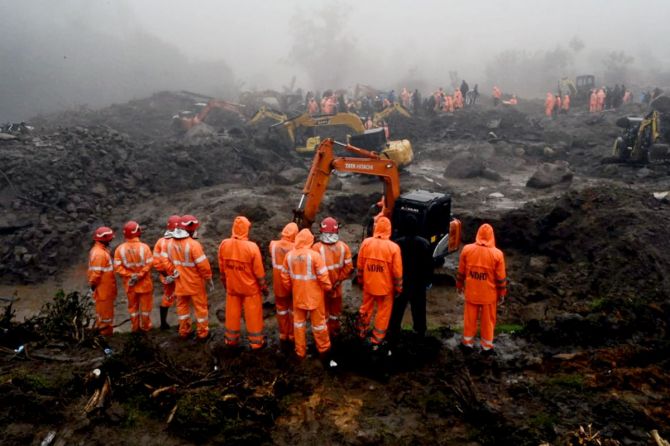'The last three decades were the era of D, where D stands for deforestation, destruction, degradation, disaster, damages, diseases, difficulties... and finally it leads to death.'

Twenty-seven landslides were reported in Kerala in 2018 during the monsoon season.
In 2019, there were 24 landslides in 24 hours.
And in 2020, more than 60 people died in a landslide in Idukki.
These numbers are from just one state during the monsoon season
India tops the world in the number of deaths due to landslides.
Dr V R Haridas, a hydro-geologist working for Caritas India, has been studying landslides in India, especially Kerala, for some time.
"We are seeing the results of what we have done three decades ago. It took us 30 to 35 years to destroy Nature to this level. Unless we make running water to walk, disasters like these will continue to happen," Dr Haridas, below, tells Shobha Warrier/Rediff.com.
For the last three years, landslides have been a regular feature during the south-west monsoon in the Western Ghats region.
The Gadgil committee report had, in fact, predicted this. As a hydro-geologist, do you also feel the same way?
Yes, it was a disaster waiting to happen, and it will continue to happen too.
These landslides are happening due to various factors. One is, the rainfall pattern has changed. It is not the same as what we had a few years back.
There was a time in Kerala when we had what you call yarn rain, when hours and hours of weak but incessant rain happened throughout the state. This kind of yarn rain will not disturb the soil structure, but allow water to seep into the underground strata of the soil.
Of late, the quantity of a droplet of rain increased from very small to big.
This is one of the important factors for soil erosion which in turn results in landslides.
The second factor is, the rainfall calendar has changed. There was a time when the rainy season started on the 1st or 2nd of June, the day schools reopened.
If Kerala got 3,000 mm rain during the season, at least 50% of the rainfall occurred in June, July and August.
Today, the pattern has changed. Towards the end of May, there was heavy rain. Then there was very less rain in June and July, but August saw a large quantity of rain happening. We see this pattern in the last three years.
The third factor is, the soil structure and texture are changing because of heavy rains.
When you go to Idukki and Wayanad areas now, you will notice that the water that is flowing is red in colour. It means there is a heavy loss of the topsoil.
You mean, what took 500 years to form, is lost in just one heavy rain?
Exactly. It takes minimum 500 years for the formation of an inch of soil, as soil is formed by the weathering of rocks.
What took 500 years to form, is lost in just a few heavy rains.
What is happening is a heavy loss of soil.
This soil is filling the dams and rivers, and the end result is the heavy siltation or sedimentation of rivers and ponds and hence disturbing their water storage capacity.
Does that mean a good reason for the floods is because most of the river beds are filled with soil?
Yes. That is one of the main reasons for the recent floods.
In 2018 and even before, during the heavy rains, top soil got moved from the hilly areas to the rivers along with sand particles clogged in clay, and this has affected the infiltration of water down.
For example, water goes down through sandy soil, but not if there is clay in it.
Water also does not seep in if there is a heavy flow of water for a short duration.
Because the run-off speed of water has increased, it does not get enough time to get absorbed.
That's why we say, allow the water to walk and not run.
So, no conservation of water is happening and even after heavy rains, groundwater level does not rise.
The time has come to intervene in the small second order streams as the soil particles are getting dislocated from the hilly areas and coming down to the foothills to fill the ponds and streams and rivers.
Is that the reason why Kerala has been experiencing droughts soon after floods?
Yes. The topsoil is not porous because of the clay particles that come down from the hills.
When the topsoil gets dislocated, the speed at which water moves increases so that water does not seep inside.
Do you attribute this to large scale mining and deforestation in the Western Ghats?
If the first reason is high intensity rainfall leading to soil erosion, this is another reason.
The second level of the problem is deforestation.
I have gone to Kavalapara in Malappuram and also Puthumalai in Wayanad where an entire village went under due to landslide.
In the late 1980s, massive deforestation had happened in these areas.
When people cut trees, they leave behind the bottom part trunk without uprooting the trees.
When the roots get decayed, it results in a trunk with no life, and it becomes a kind of a tunnel (pipe) through which rainwater goes deep underground.
 If you look at the soil structure, almost underneath the topsoil is the laterite which is like a sponge and absorbs rain water in large quantities.
If you look at the soil structure, almost underneath the topsoil is the laterite which is like a sponge and absorbs rain water in large quantities.
There is also a kind of an interface between the soil and the laterite, and laterite and the bed of rocks at the bottom.
Water, as it goes further down, collects clay particles and forms an oily surface between the soil and the laterite, and the laterite and bed of rocks.
And this causes massive landslides.
That's why when you visit the landslide areas, you get the impression that there was an oil spill.
This does not happen overnight; it takes more than three decades.
That's why today we are seeing huge landslides in the areas where massive deforestation had happened in the 1980s.
That's the reason I am saying hundreds and thousands of landslides are going to happen in the future too.
How much has climate change and warmer Earth contributed to landslides?
A lot. Climate change is affecting the rainfall pattern.
Rainfall has changed from yarn rain to high intensity rainfall.
Next is, a warmer Earth makes soil friable which results in quickening the weathering process.
Climate change has changed the entire pattern of the seasons, and we see extreme weather conditions now.
I see this as an indication of something happening to Nature which is unknown to humans.
The coronavirus itself is a result of the way Nature is behaving.
According to WHO, between 1998 and 2017, landslides have affected almost 4.8 million people and more than 18,000 people died all over the world. Is it because of the scant respect humans have for Nature?
One hundred percent!
Everything that is happening around us is connected to the way we are treating Nature.
Nature and health are inter-connected.
When you disturb Nature, your health also gets affected. That is the reason why our elders used to have a symbiotic relationship with Nature.
The last three decades were the era of D, where D stands for deforestation, destruction, degradation, disaster, damages, diseases, difficulties... and finally it leads to death.
You may remember what the Bible says, God created Nature in six days in which He used only half a day to create humans!
Though landslides are happening all over the world, studies find that 75% of the landslides occur in the Asia region, and India is among the worst affected. It is said that they are all triggered by human intervention.
There are multiple reasons for this including the character of soil.
Character of the people living in a vulnerable area, also matters.
For example, if you make trenches and bunds for filling with water, where the slope of the land is above 20o, you are inviting disaster. You see thousands of such trenches in the high ranges.
Respect for Nature is the most important thing.
Have you seen landsides happening in a forest area? That is because there is diversity and mutual support in a forest which is lacking in an area where you practice mono cropping.
When Nature is changing its character because of climate change, it is time for governments and people also to change their attitude and intervention strategies.
You said disasters like these will continue to happen in the future. Is it too late to save these areas?
Whatever Dr Madhav Gadgil said in his report in 2011, which was rubbished by the government and people, is coming true year after year.
It is actually very late, but it is better to do something before it is too late.
Unfortunately, we are seeing the results of what we have done three decades ago. It took us 30 to 35 years to destroy Nature to this level.
Unless we make running water to walk, disasters like these will continue to happen.
The time has come for us to think and talk about Nature, conservation, organic and sustainable farming. You need a lot more 'don'ts' than 'dos' to prevent landslides.
The tragic part is, today we are talking because of the landslide that happened now. After a few weeks, everybody will forget about this.
We will start talking again when the next landslide happens in 2021. That is the sad reality.










